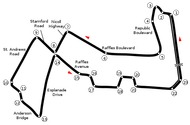After conquering the historical tracks at Spa and Monza in the final leg of the European season, the Formula One brigade heads to the exciting, spectacular and lighted up circuit at Marina Bay, Singapore for the start of a month and a half long Asian tour. The only night race on the calendar makes it a standout from any other race and hence is not worth missing. The street circuit aspect adds more zing to the adrenaline with wheel to wheel racing and exciting battles all throughout the race.
Singapore GP is by far the longest race on the calendar with race time reaching almost two hours (last year, the race had to be reduced by two laps as the two hour time limit had elapsed). The time spent also means that the drivers can feel the heat inside the car thanks to the Singapore tropical climate and it can be physically draining as the drivers can loose anywhere between 2-3 kilos of body weight. With 23 corners, the highest for a track in the calendar, the drivers experience 3-4 Gs under braking .
Here’s a look at the track info.
Track characteristics
The Marina Bay street circuit, a relatively new one on the Formula One calendar with 5 editions, typically resembles Monaco the more historical street circuit. The anticlockwise stop-start circuit is quite bumpy as it is normally open to traffic rest of the year and some parts of the track have been re-surfaced for the race.
The start-finish is a long straight that offers an overtaking opportunity and leads into the left-right-left Sheares corner at turn 1, 2 and 3 in second gear. Turn 4 is covered in fourth gear before breaking into third at turn 5, almost inches away from the wall barrier.
Turn 6 witnesses the car at full throttle with the speed touching almost 300 km/hr in seventh gear with DRS in place and provides an overtaking opportunity for the drivers before breaking at Memorial Corner for a V shaped chicane at Turn 7, 8 and 9 covered in second and third gears.
The cars reach into fifth gear at the St. Andrews Road before hitting the dreaded turn 10 called the ‘Singapore Sling’ till last year. The corner has been completely modified into a smooth flowing left-hander for the 2013 race instead of a left-right-left chicane in the earlier editions. The next left-right chicane at turn 11 and 12 is in third gear with cars moving under the Anderson Bridge before braking hard for another of the V shaped chicanes at almost a 180 degree left-hander at turn 13.
The speed guns go up after turn 13 with the cars touching 280 km/hr in fifth gear at Esplanade Drive before hitting turn 14, the last of the V shaped chicanes, before heading out to the Raffles Avenue at turns 15, 16 and 17 for another left-right-left chicane .
Turns 18-21 comprise of an inverse U shaped box chicanes which are covered in second and third gears before reaching for the final left-hander at turn 22. The gear shifts happen quickly at turn 23 to reach maximum speed (with DRS) heading back to the start-finish line.
With a high number of corners and chicanes, the drivers need to be vary of the kerbs as going hard on them will in all possibility destroy the car balance. A two-stop strategy is ideal for the Singapore GP but with rain predicted for the race weekend and the safety car involvement. this could vary from team to team.
DRS zones
Two DRS zones are defined for the race.
DRS Zone 1 – After turn 5 heading into turn 6 at Raffles Boulevard and ending just before turn 7. The detection point of this zone is at turn 4.
DRS Zone 2 – Activation after turn 23 leading to the start-finish straight and ending before turn 1. The detection point for this zone is just before turn 22.
Tyre choices
Considering the almost two-hour time spent on track, fuel load for the race distance and other track characteristics (night race, bumpy track), Pirelli have gone ahead with the supersoft tyre – the softest tyre in the range – and the medium compound replacing the soft ones used last year.
Technical Information
Lap length: 5.073km
Laps: 61
Race length: 309.316km
Lap Record: 1:45.599 Kimi Raikkonen(Ferrari),2008
Pit lane speed limit: 60km/hr
Pit lane length: 404m
Pit lane loss: approx 30 seconds
Full throttle: 46%
Braking: 21%
Fuel Consumption: 2.26 kg per lap (average)
Tyre Choice : Supersoft (Red), Medium (White)
